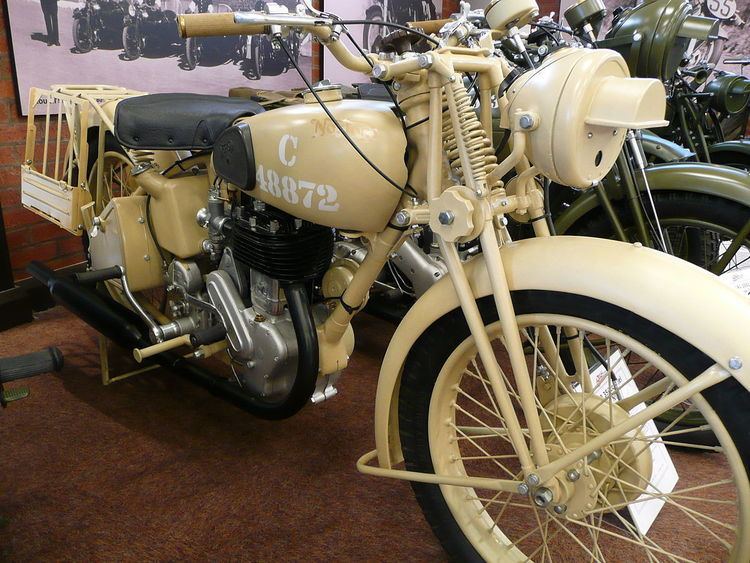Top speed 68mph (109 km/h) | ||
 | ||
Manufacturer Norton Motorcycle Company Power 14 bhp @ 4,500 rpm (Big4) Suspension Girder front forks, solid rear | ||
The Norton 16H is a designation given to British motorcycles made between 1911 through to 1954 with various modifications and refers to a single cylinder Norton 490cc side valve engine with a bore and stroke of 79 x 100 mm. The H denotes the Home model as distinct from the Colonial export model. Norton was the main military motorcycle supplier prior to WW2 and one of the main suppliers of motorcycles to the British Army in World War II with a total of nearly 100,000 produced. British Army Nortons were also supplied to the Commonwealth forces such as Australian, New Zealand, India and the Canadian Army.
Contents
Development
In 1911 James Lansdowne Norton entered a side valve 490cc single in the new 500cc Senior Class race of the Isle of Man TT. He was unplaced but the following year the motorcycle had been improved and won the Brooklands TT and set three world records.
A drive chain was developed to replace the belt drive and although production was delayed by the First World War the Model 16 as it became known gained a Sturmey Archer gearbox and had a racing heritage that included 21 world records.
In 1921 Norton launched the 'Colonial' which was a Model 16 with higher ground clearance for use on poor quality roads, and designated the UK model as the 16H (for 'Home'). Despite its initial racing successes, the 16H was considered the "poor mans Norton" and never gained the superlative descriptions popular for the Norton racing machines.
WW2 WD16H
A 16H was first offered for military evaluation in 1932, together with a Norton Model 18 and a Norton Model 19. It was found to be suitable and the Norton designers began working with the War Office on a range of developments and modifications. Military orders were placed for the 16H (designated WD16H for War Department use) from 1936 and continued throughout the course of the Second World War, setting a ten-year record for the longest time the War Office procured a single make of motorcycle. The entire staff of the Norton factory in Bracebridge Street Birmingham were needed to meet demand - even the racing team found themselves on the WD16H production line. A popular despatch machine, the WD16H was also used for training, reconnaissance, convoy control and escort duties.
Pre war, the RAF ordered many hundreds machines with a non driven 'box' or Model G (person carrying) side-car. Military Motorcycles left the Norton factory in Army Service Green, Khaki green, Khaki brown or Olive green, depending on colour specified at time of production. Prewar RAF machines (up to September 1939) were delivered in RAF Blue. Wartime RAF bikes were identically coloured as the "Army" bikes. A number of machines were painted sand 'desert camouflage' by local workshops in the Middle East and used in Palestine and the North Africa Campaign.
Military motorcycle Production
The exact number of bikes and the manufacturing dates for the military machines produced after beginning of 1940 are not certain. The Norton Assembly Books for the military motorcycles are missing and probably destroyed.
Post war
After the end of hostilities in 1945 there were many thousands of Norton Model 16H motorcycles all over the world. Some continued in use by the British and Commonwealth Armed forces until the end of the 1950s. Many were sold by the War Department to other armed forces, including the Dutch, Belgian, Danish, Greek and Norwegian Army which used the 16H throughout the 1950s. The remainder were sold to dealers who converted them to civilian colours and specifications.
The 16H and the Model 18 were also the first civilian models built by Norton after ending of the hostilities. In 1947 the machine received its final modification with telescopic forks, improving handling and giving the bike a more modern look, despite its age. The basic engine configuration proved popular with customers so Norton continued production until the mid-1950s when the fashion for twin cylinder motorcycles was prevalent. The 16H has a strong following of enthusiasts to this day.
